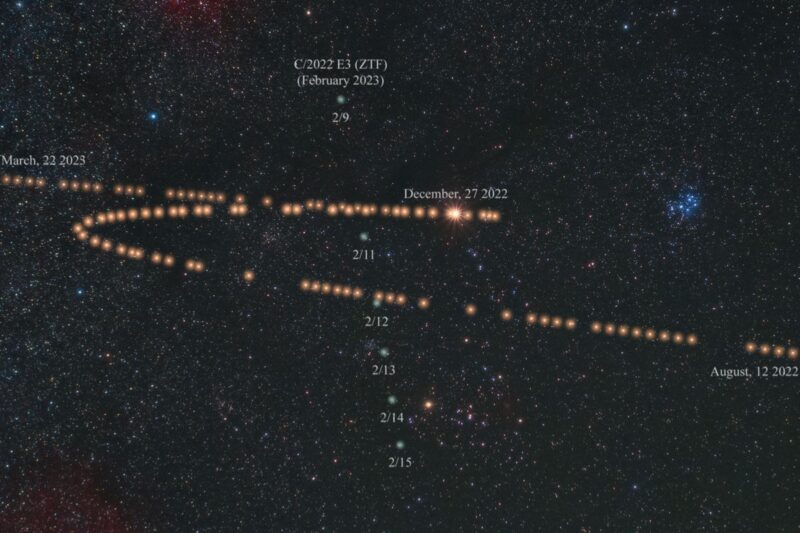
Some retrograde motion is an illusion
As measured against the fixed stars, planets typically appear to move eastward. But, sometimes, they seem to pause briefly in this eastward motion and, for some months, and then they start to move westward (backward) in front of the stars. Then they pause again. And then they start moving eastward again. Astronomers (and astrologers) call their change in direction retrograde motion.
Though it baffled ancient stargazers, we know now that this type of retrograde motion is an illusion.
You can experience this illusion in an earthbound way, the next time you pass a car on the highway. As you approach a slower car, it’s clearly moving in the same direction you are. But, as you pull alongside and pass it – from your vantage point in the faster car – the slower car may appear to move backwards for a moment. Then, as you pull ahead of it, the car appears to resume its forward motion.
The same thing happens as Earth passes the slower-moving outer planets. When we pass Jupiter or Mars or Saturn, for example, these more outward planets in orbit – which move more slowly than Earth in orbit – appear to reverse course in our sky.


It baffled early astronomers
Early astronomers believed Earth lay at the center of the universe. And so they went to complicated lengths to attempt to explain retrograde motion in that Earth-centered universe. They theorized each planet not only orbited Earth, but also spun around a moving point on their orbit known as an epicycle.
Imagine whipping a ball on a length of string around your hand while you turned in place. That’s similar to the ancient view of retrograde motion.
When it became generally accepted that Earth and the other planets orbited the sun, suddenly retrograde motion made a lot more sense.

Retrograde motion on other worlds
If you could see the sky from another planet besides Earth, retrograde illusions would lead to your seeing some very strange phenomena. On Mercury, for example, the sun sometimes appears to move in retrograde. As Mercury speeds through its closest approach to the sun, its orbital speed overtakes its rotational speed. An astronaut on the surface would see the sun partially rise, then dip back below the horizon, then rise again before resuming its east-to-west trek across the sky. The result is that, once a year, Mercury gets two sunrises on the same day!
The retrograde motion of the planets is an optical illusion, which is caused by planets orbiting the sun at different speeds to the earth
In reality, nothing changed
Yap away
The Precession of the Equinoxes also puts star signs over 2000 years out of date pic.twitter.com/1yJZsH9d4C
— Random Attack (@random836421) April 26, 2024
Of course, Mars appears to move retrograde as well. In 2024, it’ll start retrograde motion in early December and remain in retrograde motion through late February 2025. And Mars reaches opposition next in January of 2025.
i am once again tapping the “this is how retrograde motion works” sign pic.twitter.com/ISDtoOyyiy
— Seven Machina Rasmussen (@toomanyspectra) April 22, 2024
Other retrograde motion is real
Astronomers also use the word retrograde to describe true backward motion among planets and moons.
Venus, for example, rotates or spins on its axis in the opposite direction from every other planet in the solar system. If the clouds ever parted, hypothetical Venusians would see the sun rise in the west and set in the east. Astronomers would say that Venus rotates in a retrograde manner.
Some moons also have retrograde orbits around their planets. In other words, most of the large moons orbit in the same direction that their planet spins. But that’s not true of Triton, for example, the largest moon of Neptune. It orbits opposite the direction of Neptune’s spin.
Among the smaller asteroid-like moons that swarm about the giant planets, many have retrograde orbits.
It’s the same word: retrograde. But now there’s no illusion. Whether speaking of a planet’s rotation – or its orbit – if it’s opposite what you’d expect, astronomers call it retrograde.

How does it happen?
According to modern astronomers, a true retrograde orbit for an orbiting moon most likely stems from a capture. Triton, for example, might have come out of the Kuiper Belt, the region of icy debris beyond Neptune. Perhaps a collision in the belt sent Triton careening inward toward the sun. A close encounter with Neptune could have slowed it down, forcing it to settle into a backward orbit.
In past decades, astronomers have also discovered planets in distant solar systems with retrograde orbits. These exoplanets orbit their suns in the opposite direction from how the star rotates.
It’s puzzling, because planets form out of debris disks that orbit young stars. And those orbiting disks share the star’s rotation. So how does a planet end up with a true backward orbit? The only way – some astronomer’s believe – is either by a near-collision with another planet, or if another star once passed too close to the system.
Either way, close encounters can disrupt the orbits of planets and set them on a backward path!
Bottom line: Retrograde motion of planets like Jupiter or Mars in our sky is an illusion, a trick of perspective. But there’s a real retrograde motion, too.











